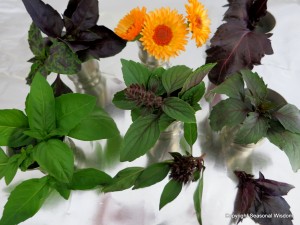
It’s hard to imagine summer cooking without basil (Ocimum basilicum). One of the most popular warm-season herbs, basil tastes wonderful whether it’s topping a pizza or puréed into pesto. With so many new varieties available to try, why not consider some new flavors? Here are six garden-fresh basil varieties from my kitchen garden:
Top row (left to right): ‘Amethyst’ and ‘Purple Ruffles’ — with calendula in middle. Middle row: ‘Genovese,’ ‘African Blue’ and ‘Ararat.’ Bottom row: ‘Genovese,’ ‘Licorice’ and ‘Amethyst.’ Learn more about these unusual basil varieties.
‘Genovese’ is the traditional Italian variety, which is often used for pesto. The green leaves smell and taste like summer. This prolific plant is open pollinated and a culinary favorite.
Here is ‘Genovese’ growing in my garden. Note the bird netting pushed to the side. When the plants are young, I’ll often cover them with netting so the hungry birds don’t eat the leaves before I do.
‘African Blue’ (left) and ‘Ararat’ (right) basils are two unusual varieties to try. ‘African Blue’ is one of the few basil varieties that is a perennial, and is pretty enough for your ornamental garden beds. This variety is also said to root easily from cuttings and grow well indoors, so I’ll be trying that this fall.
‘Ararat’ is a rare heirloom with a distinctive purple-rimmed foliage. The ornamental herb is very aromatic and has a spicy-sweet licorice flavor.
With sterile flowers, “African Blue’ doesn’t go to seed. That means you can enjoy the flowers in your garden beds and in your cooking. There is no reason to rush to remove them right away.
‘Licorice’ basil is also called ‘Anise’ or ‘Persian’ basil. The purplish-silver leaves have a spicy licorice fragrance and flavor.
As with most basil varieties, pruning the flowers keeps ‘Licorice’ basil from going to seed. It also directs the plant to grow more bushy and strong. Always cut back to a place on the stem, where two leaves are growing in opposite directions.
‘Purple Ruffles’ basil shows off its beautiful leaves with edible calendula flowers. This variety has large, frilly purple foliage. I’m infusing these pretty petals into vinegar for colorful and flavorful salads. After just a few days, the vinegar already has a lovely purple hue.
Proven Winners® Supertunia® ‘White Russian’ petunias grow happily with ‘Purple Ruffles’ basil, proving that ornamental and edible flowers are natural design partners.
‘Amethyst’ is the first and only purple ‘Genovese’ basil. The large deep purple, almost black leaves, also sometimes have spotted leaves, as you can see here.
My ‘Amethyst’ basil grows in a pot with ‘Tom Thumb’ patio tomatoes that will turn orange when ripe.
Here’s a close-up of those strangely spotted leaves on my ‘Amethyst’ basil. Despite the odd appearance, this basil tastes delightful and adds an exotic touch to summer meals.
Whatever type of basil you decide to grow, plant the herb in full sun in rich, well-amended soil. Then get creative in your summer cooking — put basil inside sandwiches, on top of scrambled eggs, scattered on gazpacho, floating in chilled drinks and much more. You can even chop basil up finely and freeze with a bit of olive oil in ice cube trays. Then pop cubes into a freezer bag for summer flavor in the dead of winter. The sky is the limit!
More on growing basil from the University of Minnesota Extension Service. What types of basil are you growing? And what’s your favorite variety?
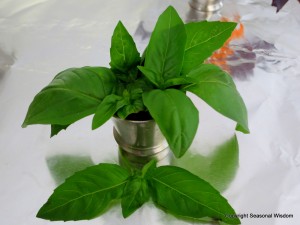
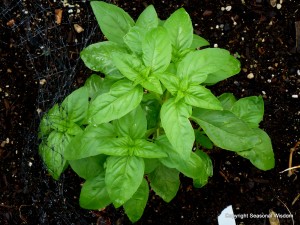
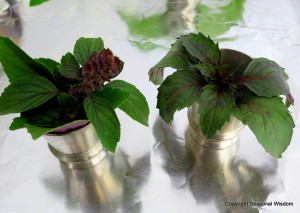
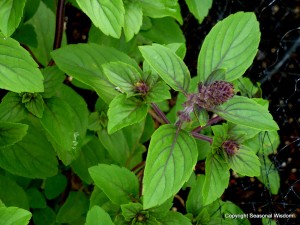
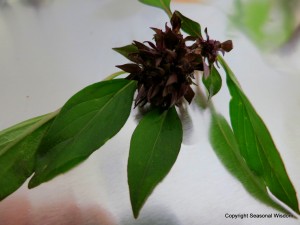


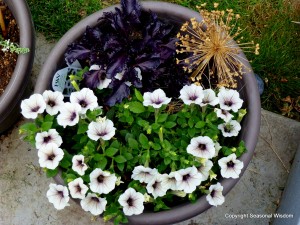
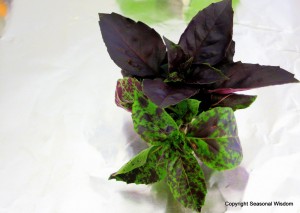
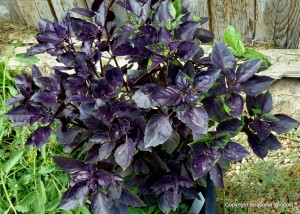
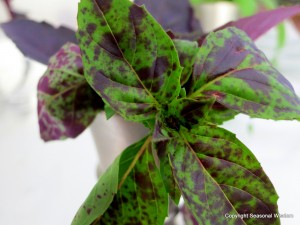











{ 3 comments }
Its Amazing..Thanks for sharing number of varieties of Basil!!
I have long wanted to run my yard organically, just keep on top of the upkeep rather than using these pesticides and other things.
However it is extremely difficult right now though where I’m living, the earth is so bad I think it would lead to a lot of problems
Well, the best thing you can do is keep working on improving the soil quality. That will make it easier to garden with chemicals. Definitely take the time to add at least three inches of good organic materials to your soil each year, such as well-aged manure, compost, worm castings, etc… A healthy soil makes a happy gardener! All best, Teresa
Comments on this entry are closed.